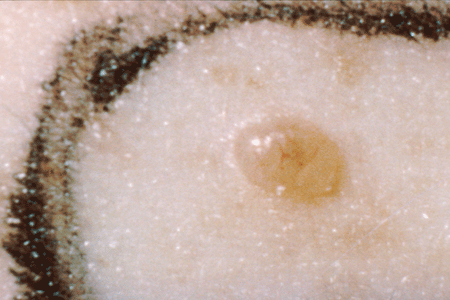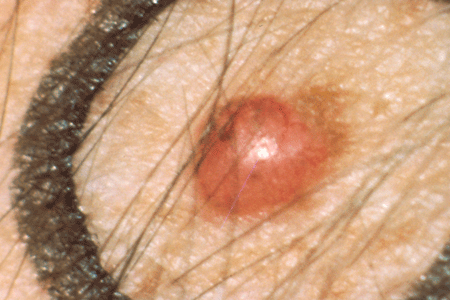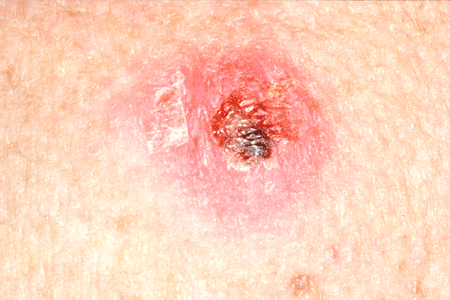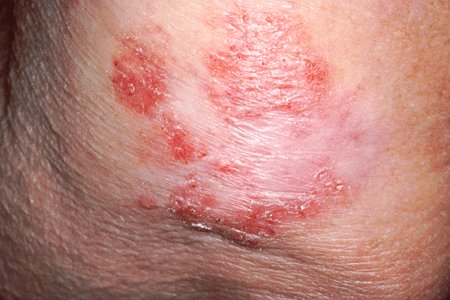skin cancer

Small, smooth, shiny, pale, or waxy lump.

Firm, red lump.

Sore or lump that bleeds or develops a crust or a scab.

Flat red spot that is rough, dry, or scaly and may become itchy or tender.

Red or brown patch that is rough and scaly.
There are three main types of skin cancer:
Of these, melanoma is the least common and most aggressive kind. There is a separate article on melanoma. The rest of this article is specifically about basal cell skin cancer and squamous cell skin cancer, which are collectively known as nonmelanoma skin cancer.
Understanding skin cancer
Skin cancer begins in cells, the building blocks that make up the skin. Normally, skin cells grow and divide to form new cells. Every day skin cells grow old and die, and new cells take their place.
Sometimes, this orderly process goes wrong. New cells form when the skin doesn't need them, and old cells don't die when they should. These extra cells can form a mass of tissue called a growth or tumor.
Growths or tumors can be benign or malignant:
· Generally, benign growths can be removed. They usually do not grow back.
· Cells from benign growths do not invade the tissues around them.
· Cells from benign growths do not spread to other parts of the body.
· Malignant growths are generally more serious than benign growths. They may be life-threatening. However, the two most common types of skin cancer cause only about one out of every thousand deaths from cancer.
· Malignant growths often can be removed. But sometimes they grow back.
· Cells from malignant growths can invade and damage nearby tissues and organs.
· Cells from some malignant growths can spread to other parts of the body. The spread of cancer is called metastasis.
Skin cancers are named for the type of cells that become cancerous. Basal cell cancer and squamous cell cancer and the two commonest kinds. These cancers usually form on the head, face, neck, hands, and arms. These areas are exposed to the sun. But skin cancer can occur anywhere.
Basal cell skin cancer grows slowly. It usually occurs on areas of the skin that have been in the sun. It is most common on the face. Basal cell cancer rarely spreads to other parts of the body.
Squamous cell skin cancer also occurs on parts of the skin that have been in the sun. But it also may be in places that are not in the sun. Squamous cell cancer sometimes spreads to lymph nodes and organs inside the body.
If skin cancer spreads from its original place to another part of the body, the new growth has the same kind of abnormal cells and the same name as the primary growth. It is still called skin cancer.
Risk factors
Doctors cannot explain why one person develops skin cancer and another does not. However, we do know that skin cancer is not contagious. You can't catch it from another person.
Research has shown that people with certain risk factors are more likely than others to develop skin cancer. A risk factor is something that may increase the chance of developing a disease.
Studies have found the following risk factors for skin cancer:
UV radiation affects everyone. But people who have fair skin that freckles or burns easily are at greater risk. These people often also have red or blond hair and light-colored eyes. But even people who tan can get skin cancer.
People who live in areas that get high levels of UV radiation have a higher risk of skin cancer. In the United States, areas in the south (such as Texas and Florida) get more UV radiation than areas in the north (such as Minnesota). Also, people who live in the mountains get high levels of UV radiation.
UV radiation is present even in cold weather or on a cloudy day.
If you think you may be at risk for skin cancer, you should discuss this concern with your doctor. Your doctor may be able to suggest ways to reduce your risk and can plan a schedule for checkups.
Prevention
The best way to prevent skin cancer is to protect yourself from the sun. Also, protect children from an early age. Doctors suggest that people of all ages limit their time in the sun and avoid other sources of UV radiation:
Symptoms
Most basal cell and squamous cell skin cancers can be cured if found and treated early.
A change on the skin is the most common sign of skin cancer. This may be a new growth, a sore that doesn't heal, or a change in an old growth. Not all skin cancers look the same. Skin changes to watch for:
Sometimes skin cancer is painful, but usually it is not.
Checking your skin for new growths or other changes is a good idea. A guide for checking your skin is below. Keep in mind that changes are not a sure sign of skin cancer. Still, you should report any changes to your health care provider right away. You may need to see a dermatologist, a doctor who has special training in the diagnosis and treatment of skin problems.
Diagnosis
If you have a change on the skin, the doctor must find out whether it is due to cancer or to some other cause. Your doctor removes all or part of the area that does not look normal. The sample goes to a lab. A pathologist checks the sample under a microscope. This is a biopsy. A biopsy is the only sure way to diagnose skin cancer.
You may have the biopsy in a doctor's office or as an outpatient in a clinic or hospital. Where it is done depends on the size and place of the abnormal area on your skin. You probably will have local anesthesia.
There are four common types of skin biopsies:
You may want to ask your doctor these questions before having a biopsy:
Staging
If the biopsy shows that you have cancer, your doctor needs to know the extent (stage) of the disease. In very few cases, the doctor may check your lymph nodes to stage the cancer.
The stage is based on:
These are the stages of skin cancer:
For treatment options, go to the article on skin cancer treatment.
Skin self-exam
Your doctor or nurse may suggest that you do a regular skin self-exam to check for skin cancer, including melanoma.
The best time to do this exam is after a shower or bath. You should check your skin in a room with plenty of light. You should use a full-length mirror and a hand-held mirror. It's best to begin by learning where your birthmarks, moles, and other marks are and their usual look and feel.
Check for anything new:
Check yourself from head to toe. Don't forget to check your back, scalp, genital area, and between your buttocks.
By checking your skin regularly, you will learn what is normal for you. It may be helpful to record the dates of your skin exams and to write notes about the way your skin looks. If your doctor has taken photos of your skin, you can compare your skin to the photos to help check for changes. If you find anything unusual, see your doctor.


